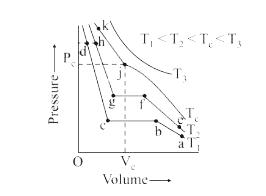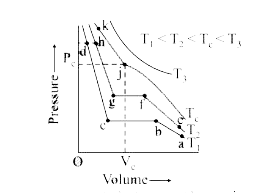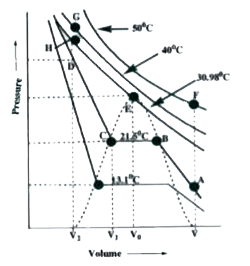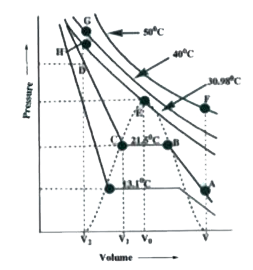Study the following isotherms of carbondioxide at various temperature and answer the following questions based on that:

Choose the temperature above which CO2 cannot be liquified whatsoever applied pressure isSolution in Telugu
290K
294.5 K
302K
304 K
Above TC gas cannont be liquified
TC=30.98∘C=303.98K.
Topper's Solved these Questions
- BOOK - AAKASH SERIESCHAPTER - STATES OF MATTEREXERCISE - LECTURE SHEET - EXERCISE - IV (LEVEL - II ADVANCED)(MATRIX MATCHING TYPE QUESTIONS)3videos
STATES OF MATTER
- BOOK - AAKASH SERIESCHAPTER - STATES OF MATTEREXERCISE - LECTURE SHEET - EXERCISE - IV (LEVEL - II ADVANCED)(INTEGER TYPE QUESTIONS)4videos
STATES OF MATTER
- BOOK - AAKASH SERIESCHAPTER - STATES OF MATTEREXERCISE - LECTURE SHEET - EXERCISE - IV (LEVEL - II ADVANCED)(MORE THAN ONE CORRECT ANSWER TYPE QUESTIONS)9videos
STATES OF MATTER
- BOOK - AAKASH SERIESCHAPTER - SATURATED HYDROCARBONSEXERCISE - QUESTIONS FOR DESCRIPTIVE ANSWERS10videos
SATURATED HYDROCARBONS
- BOOK - AAKASH SERIESCHAPTER - STOICHIOMETRYEXERCISE - QUESTIONS FOR DESCRIPTIVE ANSWERS59videos
STOICHIOMETRY
Similar Questions
Column-I Column-II A) Hydrogen gas (P = 200 atm, T = 273K) P) Compressibility factor ≠1B) Hydrogen gas (P≈0,T=273K)Q) Attractive forces are dominant C)CO2(P=1atm,T=273K)R)PV=nRTD) Real gas with very large molar volume S)P(V−nb)=nRT
04:33View SolutionExcluded volume for free random motion of gas molecules is how many times the actual volume of gas molecules
04:21View Solution2 moles of Xenon is present in a one litre vessel. For Xenon gas a=4.19lt2. atm. mol−2, b = 0.05 lt/mol. The volume of free space available for random motion of molecules is
04:20View SolutionWhy boiling and melting points of hydrocarbons are low ?
04:58View SolutionDistinguish between element and compound?
04:53View SolutionIsotherms of carbon dioxide at various temperatures are represented in figure. Answer the following questions based on this figure. In which state will CO_(2) exist between the points a and b at temperature T_(1) ?
View SolutionIsotherms of carbon dioxide at various temperatures are represented in figure. Answer the following questions based on this figure. At what point will CO_(2) start liquefying when temperature is T_(1) ?
03:22View SolutionIsotherms of carbon dioxide at various temperatures are represented in figure. Answer the following questions based on this figure.

At what point will CO2 be completely liquefied when temperature is T2 ?02:59View SolutionIsotherms of carbon dioxide at various temperatures are represented in figure. Answer the following questions based on this figure.

Will condensation take place when the temperature is T3?04:28View SolutionIsotherms of carbon dioxide at various temperatures are represented in figure. Answer the following questions based on this figure. What portion of the isotherm at T_(1) represent liquid and gaseous CO_(2) at equilibrium?
02:17View SolutionAnswer the following questions based on the P-T phase diagram of CO2:
CO2 at 1 am pressure and temperature −60∘C is compressed isothermally Does it go through a liquid phase ?02:10View SolutionAnswer the following questions based on the P-T phase diagram of CO_(2) : CO_(2) at 1 am pressure and temperature - 60^(@) C is compressed isothermally Does it go through a liquid phase ?
06:03View SolutionStudy the following isotherms of carbondioxide at various temperature and answer the following questions based on that: Choose the temperature above which CO_(2) cannot be liquified whatsoever applied pressure is
03:44View SolutionStudy the following isotherms of carbondioxide at various temperature and answer the following questions based on that:

At 21.5°C decrease in volume(B-C) doesn't result into increase in pressure because04:27View SolutionStudy the following isotherms of carbondioxide at various temperature and answer the following questions based on that:

Carbondioxide present at F can be liquified04:14View Solution

